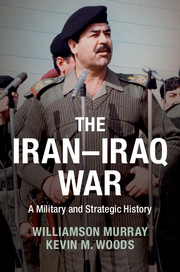Book contents
- Frontmatter
- Dedication
- Contents
- List of figures
- List of tables
- Preface
- Acknowledgments
- Note to reader
- 1 Introduction
- 2 A context of “bitterness and anger”1
- 3 The opponents
- 4 1980: The Iraqi invasion begins
- 5 1981–1982: Stalemate
- 6 Defeat and recovery
- 7 1983–1984: A war of attrition
- 8 1985–1986: Dog days of a long war
- 9 1987–1988: An end in sight?
- 10 Conclusion
- Appendix A Timeline
- Appendix B People
- Appendix C Place names
- Appendix D Order of battle
- Bibliography
- Index
- References
4 - 1980: The Iraqi invasion begins
Published online by Cambridge University Press: 05 September 2014
- Frontmatter
- Dedication
- Contents
- List of figures
- List of tables
- Preface
- Acknowledgments
- Note to reader
- 1 Introduction
- 2 A context of “bitterness and anger”1
- 3 The opponents
- 4 1980: The Iraqi invasion begins
- 5 1981–1982: Stalemate
- 6 Defeat and recovery
- 7 1983–1984: A war of attrition
- 8 1985–1986: Dog days of a long war
- 9 1987–1988: An end in sight?
- 10 Conclusion
- Appendix A Timeline
- Appendix B People
- Appendix C Place names
- Appendix D Order of battle
- Bibliography
- Index
- References
Summary
We have to stick their nose in the mud so we can impose our political will over them. This cannot take place except militarily.
– Saddam HusseinOh great people of Iraq … We thought the Iranian government was going to learn from the previous lessons after our valiant troops liberated our extorted land on the eastern borders [the two towns the Iranians were supposed to return after the signing of the 1975 Accords], and after we reinstated Iraqi sovereignty in Shatt al-Arab. But the grandsons of the magi who have [a] deep grudge against Iraq and the Arab nation, and who are strong in setting suspicious plans continued in their errors and counter military actions … Oh … sons of Iran of all nationalities, religions and sects … we do not want to inflict any damage on you or seek your land, but the tyrant charlatan Khomeini and his aides want to be in an unfaithful war against us, motivated by an unjustified … grudge against Iraq … They wanted to deceive Iraq and [the] Ummah, and the backward … Khomeini gang committed massacres and caused the Iranian people a blood bath.
– Saddam HusseinDespite the momentous changes occurring in Iran during early 1979, Saddam was still looking west. At the end of March, a meeting and discussions between the Ba’ath Revolutionary Command Council and members of the PLO, chaired by then-vice president Saddam Hussein, focused on Egyptian President Anwar al-Sadat’s defection from the Arab hardline states. Saddam was clear on the policies he believed the Arab world should pursue:
We stated that there would be traitors, and we would deal with them on that basis by [encouraging] the people to [do] all they can to topple the regime for treason. We said it publicly … We repeated it today, the same words. I fear they think that those are just words for the public, but that it is not for them also.
- Type
- Chapter
- Information
- The Iran–Iraq WarA Military and Strategic History, pp. 85 - 137Publisher: Cambridge University PressPrint publication year: 2014



